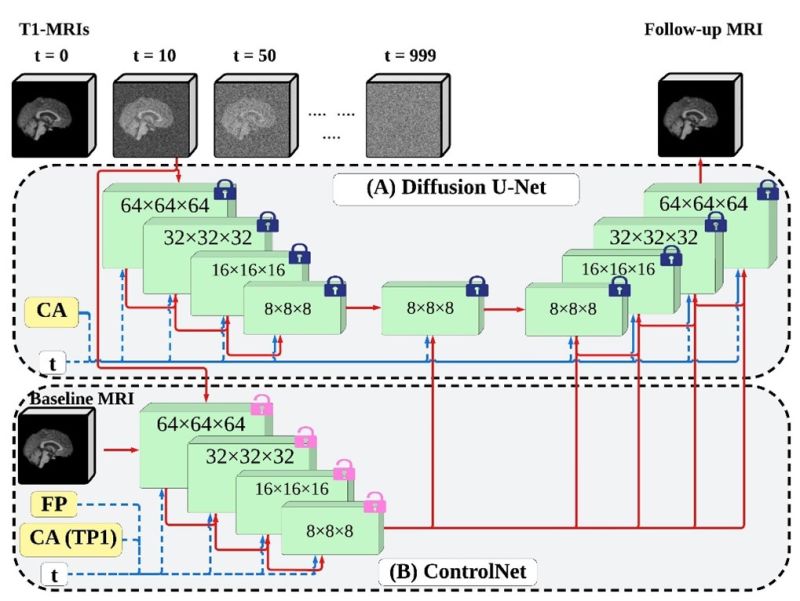
Predictive AI model could help forecast neurodegenerative diseases
Neurodegenerative diseases like Alzheimer's are a growing concern in the U.S., with over 7 million Americans living with Alzheimer's disease today. By 2060, that number is expected to grow, affecting nearly 13 million people. These diseases are not only hard on individuals and families, but are costly, with more than $230 billion spent in the U.S. each year in caregiving alone. As the population ages, the need for new ways to detect and address the silent emergence of these diseases has never been more urgent.
New artificial intelligence predictive models used in brain research may provide a way to better predict how a person's brain ages over time, helping doctors recognize warning signs long before clinical symptoms surface.
Supported by the U.S. National Science Foundation, a team of researchers led by Paul Bogdan, an associate professor in the University of Southern California Department of Electrical and Computer Engineering, has developed a cutting-edge AI system capable of generating a future MRI of a person's brain from just a single scan. This technology opens the door to identifying subtle changes that may signal the earliest stages of neurodegenerative diseases — potentially years before traditional diagnostic methods could detect them.
To build the tool, the team combined two advanced AI techniques: a 3D diffusion model and a ControlNet, which allow the system to "control" or guide image generation based on input data. In this case, the input is a baseline brain MRI from a healthy adult. From that single image, the AI model predicts a realistic follow-up MRI, simulating how that specific brain might look years later.

Credit: Gengshuo Liu, University of Southern California
This research was funded by multiple NSF grants — including those focused on medical cyber-physical systems, uncertainty modeling and formal methods that enhance trustworthiness — and brought together multidisciplinary fields such as health care, cyber-physical systems, mathematical modeling and formal methods. Researchers included Gengshuo Liu (electrical and computer engineering doctoral student), Nikhil Chaudhari (biomedical engineering doctoral student), Nikos Kanakaris (engineer), Chenzhong Yin (data science expert) and Andrei Irimia (neuroscientist).
The NSF funding was instrumental to laying the groundwork for brain modeling research, developing mathematical frameworks that capture the time-dependent, complex spatiotemporal physiological changes of the brain and ensuring the robustness and reliability of the AI-generated MRIs to generate not just accurate images, but also meaningful insights about how the brain evolves.
"NSF support was absolutely essential for thinking outside the box and critical to our successful AI model solving an urgent challenge our society faces — detecting neurological disorders very early on in order to take proactive measures and improve quality of life," said Bogdan. "Each of these projects gave us critical building blocks — from modeling complex systems, to handling uncertainty, to making machine learning more explainable. Without that foundation, this level of scientific integration and investigation wouldn't have been possible."
The implications of this work are significant for early detection of Alzheimer's and other neurodegenerative diseases, significant reduction of health care costs and improvement to the quality of life of patients and caregivers.

Credit: Gengshuo Liu, University of Southern California
And the applications don't stop there. The AI framework used in this study could also be adapted to predict changes in other organs or body systems, enabling more personalized and preventive care across many health conditions. Researchers plan to expand the training dataset to include individuals with different follow-up intervals and a wider age range. They are also exploring clinical partnerships with anyone interested in extending these AI models and validating them in real-world health care settings.
In the future, a single MRI taken during a routine checkup could give doctors a window into a person's neurological future and help take proactive measures so that certain neurological disorders are either avoided or their onset significantly delayed. With continued federal investments, tools like this could one day become part of standard preventive medicine and save countless lives.
Distribution channels: Science
Legal Disclaimer:
EIN Presswire provides this news content "as is" without warranty of any kind. We do not accept any responsibility or liability for the accuracy, content, images, videos, licenses, completeness, legality, or reliability of the information contained in this article. If you have any complaints or copyright issues related to this article, kindly contact the author above.
Submit your press release